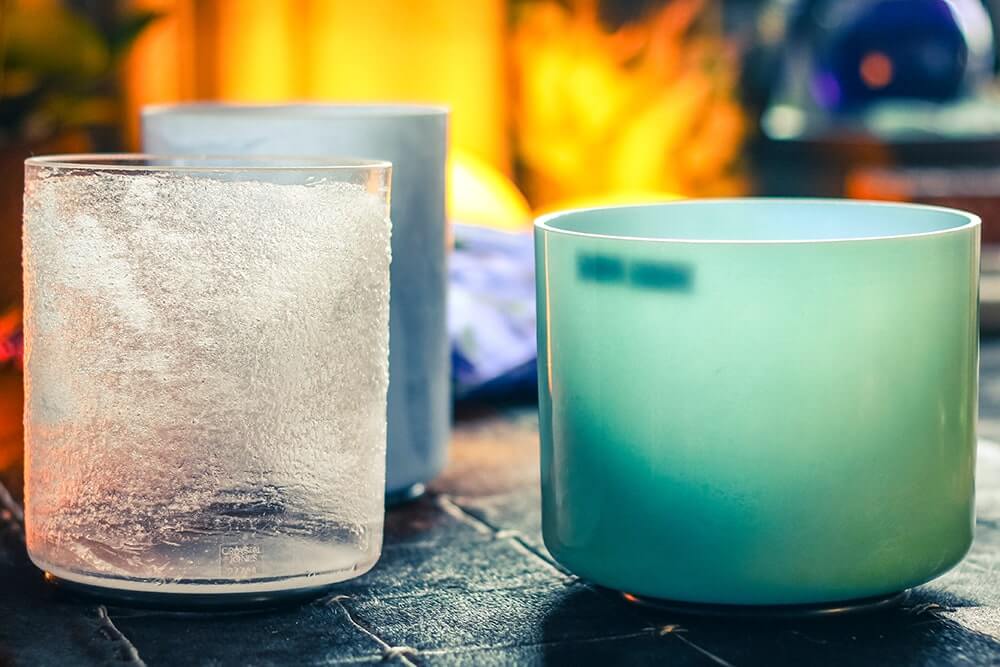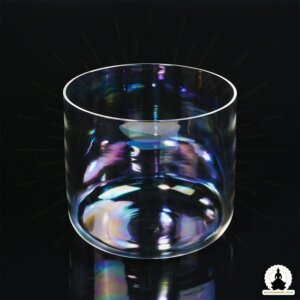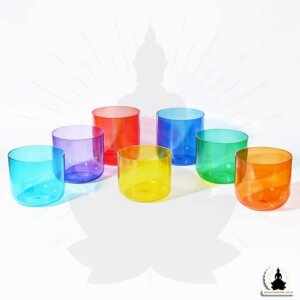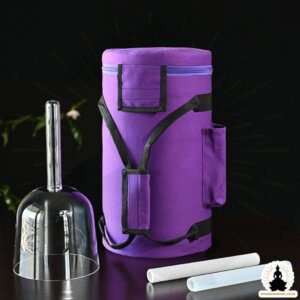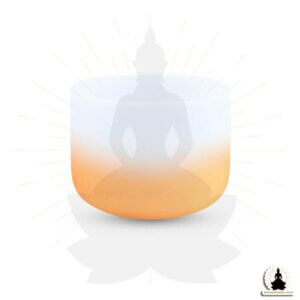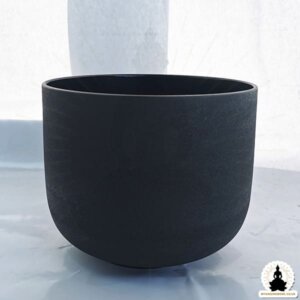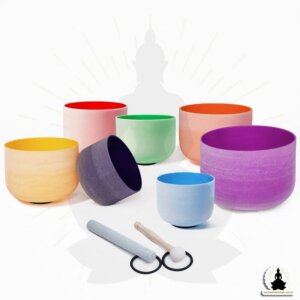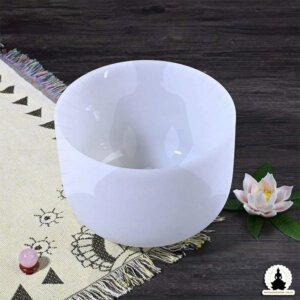Crystal singing bowl
From mineral to melody: the complete process of making quartz crystal bowls
Since their recent appearance in the world of holistic healing and meditation, crystal singing bowls have captivated with their ethereal sounds and sparkling beauty. These fascinating and mystical instruments have their origins in the heart of the earth, where quartz, their main component, is mined.
This guide takes you on a detailed journey to discover the process of transforming raw quartz into an exquisite crystal bowl and how this modern instrument is used in lithotherapy. Whether you’re new to crystal bowls or looking to deepen your understanding of these remarkable instruments, this article will provide you with a comprehensive overview.
In the next sections, we’ll explore the unique properties of quartz, the detailed process of making crystal bowls, the different types of bowls, their use in lithotherapy and, finally, how to choose and care for your own crystal bowls.
Understanding crystal
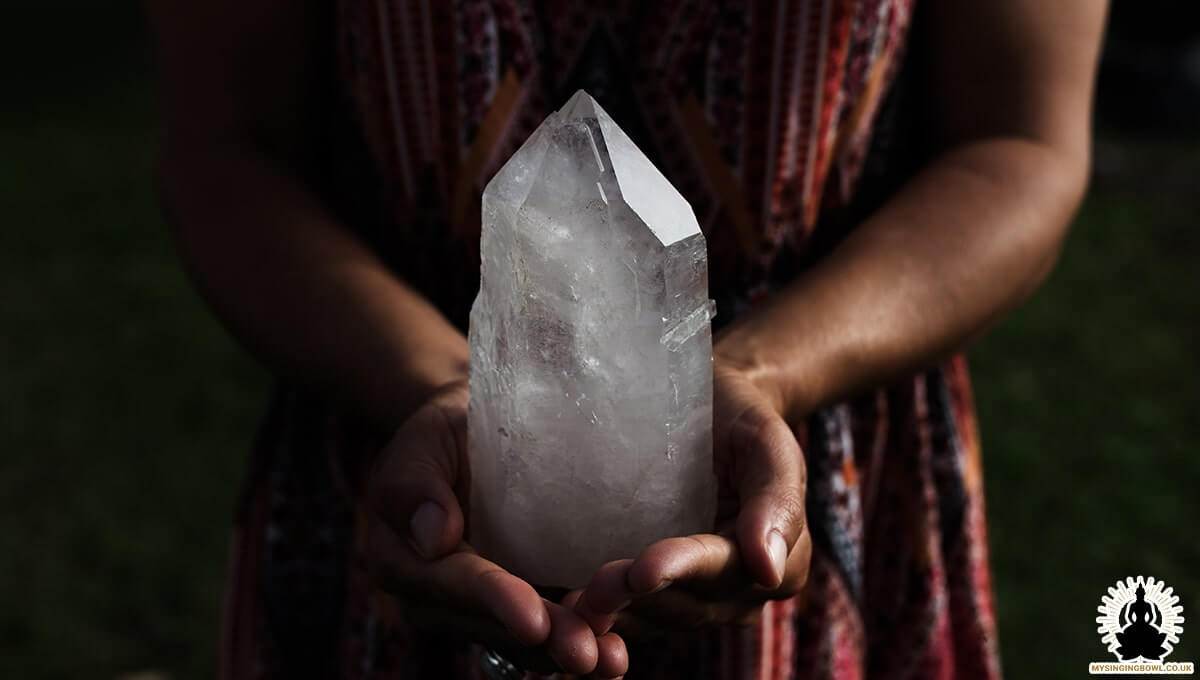
Introduction to quartz crystal: origins and properties
Quartz crystal is one of the most abundant minerals on earth, and is known for its hardness, transparency and resilience. It has been used throughout the ages in different cultures for a variety of purposes, from jewellery to healing tools. Quartz crystals are also piezoelectric, meaning they produce an electrical voltage when subjected to mechanical pressure. It is this property that gives quartz its incredible ability to produce pure sound and long resonance when cut and polished into the shape of a bowl.
Different types of crystal used to make bowls
Although clear quartz is most commonly used to make crystal bowls, other types of crystal, such as rose quartz, smoky quartz and rutilated quartz, are also used. Each of these crystals has unique properties, and the type of crystal used will influence the colour, sound and resonance of the bowl.
The role of crystals in lithotherapy
Lithotherapy is an ancient practice that uses the energetic vibrations of stones to help balance the body and mind. In this context, quartz crystals are particularly valued for their purifying, healing and energy-amplifying properties. When used in the form of crystal bowls, these properties are said to be amplified, providing a powerful means of cleansing and recharging the energetic body.
The acoustic and vibrational properties of quartz
This is where the acoustic and vibrational properties of quartz come into play in the manufacture of crystal bowls. Thanks to its regular crystalline structure and its ability to resonate at a precise frequency when struck or rubbed, quartz can produce tones of remarkable purity and consistency. These acoustic properties, combined with its piezoelectricity, enable quartz crystal bowls to produce sounds and vibrations of exceptional clarity and duration, making them ideal for use in meditation and sound therapy.
Crystal singing bowl manufacturing process
Extraction and selection of crystals
The adventure of making a crystal singing bowl begins underground, where quartz crystals are carefully extracted. This extraction is carried out carefully to preserve the integrity of the crystal as much as possible. Once extracted, the crystals are sorted by size, quality and clarity. Only the highest quality crystals are selected for the manufacture of our crystal bowls.
Powdering and cleaning the quartz
The next step in creating crystal bowls is to turn the raw quartz, also known as silicon dioxide, into powder. This is a delicate process, as it must be carried out in such a way as to preserve the crystalline structure of the quartz. Once the quartz powder has been obtained, it is carefully cleaned to remove any residual impurities. This is a crucial step, as even the smallest impurities can affect the clarity and sound quality of the final bowl.
Quartz crystallisation
The third stage is quartz crystallisation. The quartz powder is placed in a furnace at very high temperature to be melted. During this stage, the quartz undergoes a transformation, going from a solid state to a liquid state, but retaining its crystalline structure. It is this melting process that creates the crystal from which the bowl will be formed.
Treatment of the bowl and sandblasting
Once formed, the bowl undergoes a gas treatment to obtain its distinctive frosted appearance (if it is a frosted bowl). Next, the bowl is cleaned in several baths of water to remove any residual gas or other impurities. This step is vital to ensure the purity of the bowl. After cleaning, the bowl is cooled by sandblasting, which reinforces the hardness of the crystal and prepares the bowl for the final polishing stage.
Polishing and final inspection
The final stage of the process is the polishing of the bowl. This step improves the shine and clarity of the bowl, giving it a smooth, pleasant-to-the-touch finish. Once polishing is complete, each bowl undergoes a rigorous inspection to ensure its sound and visual quality. Only bowls that pass this inspection are considered ready for use.
So making crystal bowls is a labour-intensive and time-consuming process, requiring great expertise and attention to detail. The result is a beautifully crafted instrument capable of producing sounds and vibrations of unrivalled quality.
The different types of crystal bowl
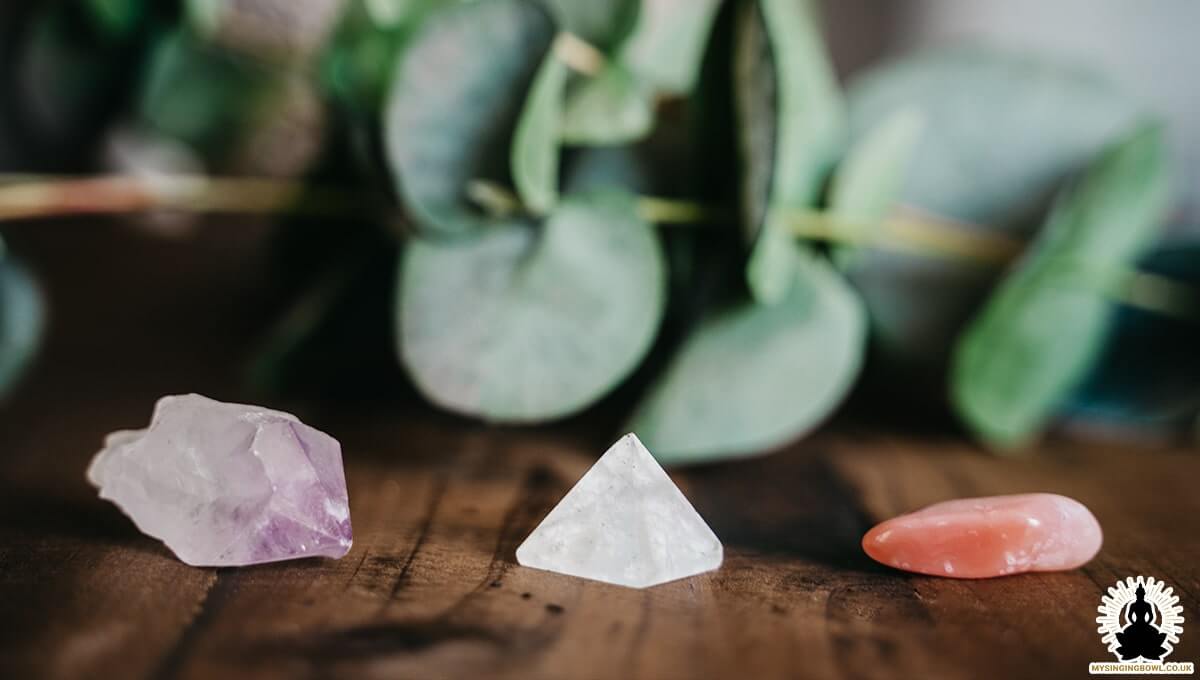
Clear crystal bowl
Recognisable by their matt surface and whitish appearance, frosted crystal bowls are made from clear quartz, but undergo a process of sandblasting or acidification to give them their ‘frosted’ appearance. This not only alters their appearance, but also changes their sound, giving them a deeper, richer tone than their clear counterparts. The manufacturing process for frosted crystal bowls is similar to that of clear crystal bowls, but requires additional steps to create the frosted finish.
Transparent crystal bowl
These crystal bowls, often called “optical crystal bowls”, are made from the highest quality quartz which is extremely pure and clear. Their manufacturing process is more complex and requires more time and expertise than frosted crystal bowls. The sound produced by transparent crystal bowls is generally clearer and higher-pitched, with a longer resonance. Their clarity and purity also make them popular choices for use in lithotherapy.
Coloured crystal bowls
Coloured crystal bowls are created by adding minerals and colouring elements to the quartz during the melting process. For example, adding iron produces a green crystal bowl, while adding manganese produces a purple bowl. Not only do these bowls add visual beauty, but each colour is also believed to have its own therapeutic properties in lithotherapy. For example, a green crystal bowl would be beneficial for the heart, while a red bowl would be beneficial for the root chakra. So each type of crystal bowl has its own beauty, sound and vibration, offering a range of sensory and therapeutic experiences.
Crystal bowls and lithotherapy
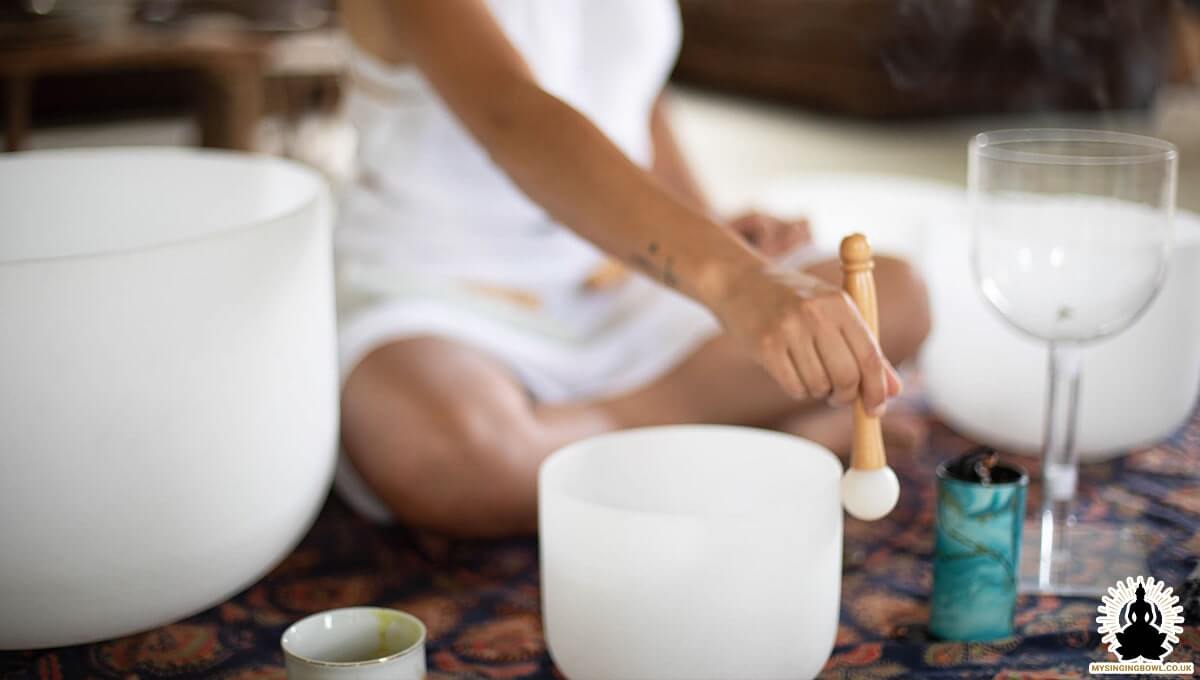
Introduction to lithotherapy
Lithotherapy is a holistic practice that uses the energy of stones to promote health and well-being. Each stone has a unique vibration that can interact with our bioenergetic field to promote balance and healing. Crystal bowls, with their harmonious sounds and powerful vibrations, are invaluable tools in lithotherapy.
How crystal singing bowls are used in lithotherapy
In lithotherapy, crystal bowls are often used to rebalance and harmonise the chakras, or energy centres of the body. Depending on the sound and colour of the bowl, it can be used to target a specific chakra. For example, a red crystal bowl could be used to balance the root chakra, while a blue crystal bowl could be used to balance the throat chakra.
Potential benefits for health and well-being
The therapeutic effects of crystal bowls go beyond simple relaxation. They can help reduce stress and anxiety, improve sleep, increase mental clarity and even promote physical healing. In addition, crystal bowls can help facilitate meditation and can be used in yoga and reiki practices to improve energy and concentration.
The benefits of crystal on the human body
The vibrations of crystal singing bowls have a profound effect on the human body, which itself is over 70% water. The sound waves produced by the crystal bowls can create ripples and patterns in the water in our bodies, like a pebble thrown into a pond.
These vibrations can help to ‘tune up’ cells in our body that have been thrown out of balance by stress, illness or negative emotions. Some research even suggests that the vibrations of sound can have an impact at a molecular level, helping to reduce inflammation and increase the production of certain immune system cells.
The sounds and vibrations of the crystal bowls can also affect our nervous system, slowing brain waves to induce states of deep relaxation and promote the release of stress and anxiety. It is in these states of deep relaxation that our bodies are able to regenerate and heal themselves.
Recommended practices for effective therapeutic use
For effective use in lithotherapy, we recommend playing the crystal bowl in a calm environment and concentrating on the sound vibrations. Conscious listening, combined with deep breathing, can help to maximise the therapeutic benefits. It is also advisable to clean the crystal bowls regularly to eliminate any residual energy and maintain their pure vibration. So crystal bowls are not only beautiful objects, but also powerful tools for healing and well-being.
Buying and caring for your crystal bowls

Tips for choosing the right crystal bowl
Choosing a crystal bowl depends largely on your personal preferences and how you intend to use it. In general, it’s important to choose a bowl that resonates with you, both in terms of sound and colour. If possible, try out several bowls before making your choice. Listen carefully to their sound and feel their vibration to determine which one suits you best.
How to clean and care for your crystal bowl
It’s important to clean your crystal bowl regularly to eliminate residual energies and maintain the clarity of its sound. To clean it, you can run it under running water with the intention of cleaning it. You can also clean it with sage smoke or by placing it in sunlight or moonlight to recharge it. Avoid using chemical or abrasive products to avoid damaging your bowl.
Precautions to take when using crystal bowls
Although crystal bowls are generally solid, they can still break or crack if handled incorrectly. So handle them with care. Avoid exposing them to extreme temperatures and don’t play with them too hard. It’s also important to remember that each bowl has its own resonance and may not be suitable for everyone. If you feel any discomfort or discomfort when using a crystal bowl, stop using it and consult a health professional or lithotherapy therapist.
Owning and using a crystal singing bowl can be a rewarding and therapeutic experience. With the right care and respect, these beautiful instruments can serve you for many years and become a valuable part of your wellness routine.
Conclusion
The art of crystal bowls transcends simple visual beauty to offer a profound sensory and therapeutic experience. From the meticulous extraction of quartz crystals to the delicate shaping and tuning of these instruments, each stage in the manufacture of crystal bowls is a demonstration of skill, patience and passion.
Whether it’s the frosted crystal bowls with their deep, rich sound, the clear crystal bowls with their brilliant purity, or the coloured crystal bowls with their unique visual appeal, each type of bowl offers a unique experience and therapeutic potential in lithotherapy.
However, as with any therapeutic practice, it is important to approach the use of crystal bowls with respect and awareness, ensuring that you choose the right bowl for you, clean and maintain it regularly, and use it safely and respectfully.
Ultimately, the experience of a crystal bowl is very personal and depends very much on your receptivity to its vibrations. With the right intention and approach, using a crystal bowl can be a powerful and transformative practice, offering a pathway to relaxation, harmony and well-being.

